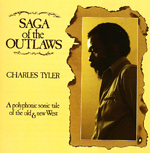|
|
 |
Dusted Reviews
Artist: Charles Tyler Album: Saga of the Outlaws Label: Nessa Review date: Apr. 2, 2009 |

|
|
|
 |
It’s wonderful to see the legendary jazz label Nessa Records active again. Last year’s long-sought reissue of Roscoe Mitchell’s Nonaah came first, now it’s the first CD appearance of Charles Tyler’s momentous 1970s improvised session. Recorded live in Sam Rivers’ loft during the same sessions that produced the legendary Wildflowers recordings, this single 36-minute track documents a performance of huge dynamic range and overwhelming beauty from one of the music’s most underrepresented figures.
Alto saxophonist Charles Tyler’s sound is as large as his discography is small. He is represented by only a handful of releases, several of which are out of print at this writing, making the return of Saga of the Outlaws doubly welcome. His instrumental approach bears the hallmark of his time with Albert Ayler, with whom he cut some highly influential material for the then fledgling ESP-Disk’ label. Saga shares Ayler’s deep roots in uhr-blues, but Tyler was also gifted with the ability to allow something very close to the center of his consciousness to emerge from his saxophone. Each moment brings a change in register or a shift in mood, often accompanied by timbral modification. All of the motivic development that signals great soloing is there; listen, for example, to the three-note figure that emerges at 8:02 and dominates proceedings during the next 20 seconds, remerging briefly several minutes later. Even this brief stretch of time is filled with whiplash invention, as ideas pour from the alto. Very few – Ayler, Trane and Jimmy Lyons among them – share in this ability to fuse the remnants of bebop with the “new thing” aesthetic of the 1960s. Tyler’s higher registers are pierced with pain, and his growls emanate from a bottom beyond the simple vision afforded by such a clumsy phrase as “free jazz.”
His bandmates are equal partners on the journey. Revel in Steve Reid’s massive drum solo, beginning in fierce but controlled abandon and simmering down through multi-hued taps and rattles to a series of moans, only to explode with repeated and rhythmic thunderclaps. The hard-hitting bass team of John Ore and Ronny Boykins support and enhance all other activity by laying down streams of counterpoint laced with the rhythms of funk, a trope Reid is only too happy to engage at strategic moments. Earl Cross spins out beautiful post-bop trumpet lines ala Booker Little, but his arsenal also includes menacing growls and meditative zephyrs of tone that cool the heated rhythm section.
As the opening material is reprised at journey’s end, there is a sense of wonder at how much has transpired and how different the familiar material can sound after all that has ensued. The date is a landmark, both for the Nessa catalog and the AACM movement as a whole.
By Marc Medwin
|







